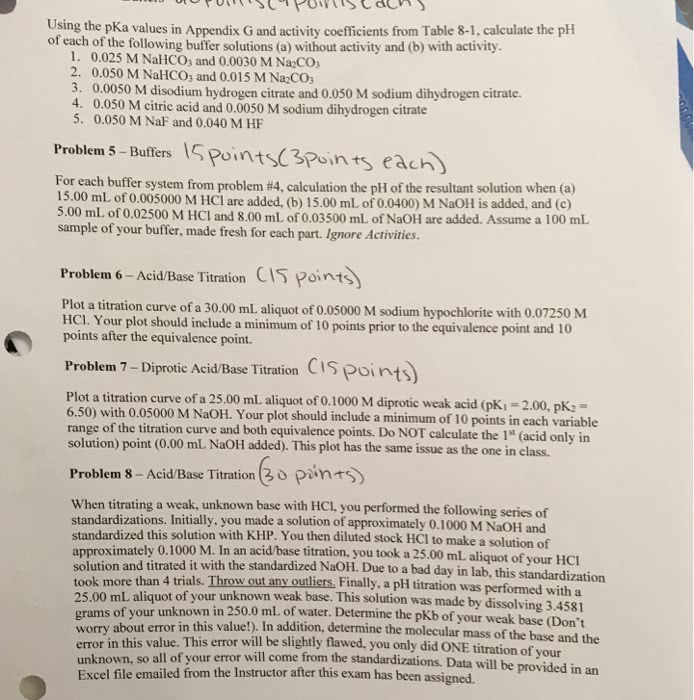PH experiment:
What is one real-world or practical application for this experiment or portion of this experiment?
Define the following: abscissa, acid, base, endpoint, equivalence point, neutralization, pH, pKa, mono- protic acid, polyprotic acid, ordinate, strong acid, strong base, and weak acid.
Draw the structure of each of the acids in Table 1.
Produce data tables for each of your runs. Leave room in your notebook for lots of data. Record the actual volume of titrant and solution pH as you conduct the experiment.
Identify all potentially hazardous steps in your procedure. In your own words, explain what safety precautions should be taken and why.
Consider the titration of 0.050 M HCl with 0.050 M NaOH. Calculate the pH: (a) of the pure HCl solution; (b) of 25.00 mL acid plus 12.50 mL base; (c) at the equivalence point; and (d) of 25.00 mL acid and 37.50 mL base.
Consider the titration of 0.050 M NaOH with 0.050 M HCl. Calculate the pH: (a) of the pure NaOH solution; (b) of 25.00 mL base plus 12.50 mL acid; (c) at the equivalence point; and (d) of 25.00 mL base and 37.50 mL acid.
In one experiment, an unknown acid was titrated with NaOH. The pH at the equivalence point was 7.75. Was the unknown acid strong or weak? Explain. Hint: The pH of pure water at room temperature is 7.
PH experiment:
What is one real-world or practical application for this experiment or portion of this experiment?
Define the following: abscissa, acid, base, endpoint, equivalence point, neutralization, pH, pKa, mono- protic acid, polyprotic acid, ordinate, strong acid, strong base, and weak acid.
Draw the structure of each of the acids in Table 1.
Produce data tables for each of your runs. Leave room in your notebook for lots of data. Record the actual volume of titrant and solution pH as you conduct the experiment.
Identify all potentially hazardous steps in your procedure. In your own words, explain what safety precautions should be taken and why.
Consider the titration of 0.050 M HCl with 0.050 M NaOH. Calculate the pH: (a) of the pure HCl solution; (b) of 25.00 mL acid plus 12.50 mL base; (c) at the equivalence point; and (d) of 25.00 mL acid and 37.50 mL base.
Consider the titration of 0.050 M NaOH with 0.050 M HCl. Calculate the pH: (a) of the pure NaOH solution; (b) of 25.00 mL base plus 12.50 mL acid; (c) at the equivalence point; and (d) of 25.00 mL base and 37.50 mL acid.
In one experiment, an unknown acid was titrated with NaOH. The pH at the equivalence point was 7.75. Was the unknown acid strong or weak? Explain. Hint: The pH of pure water at room temperature is 7.

